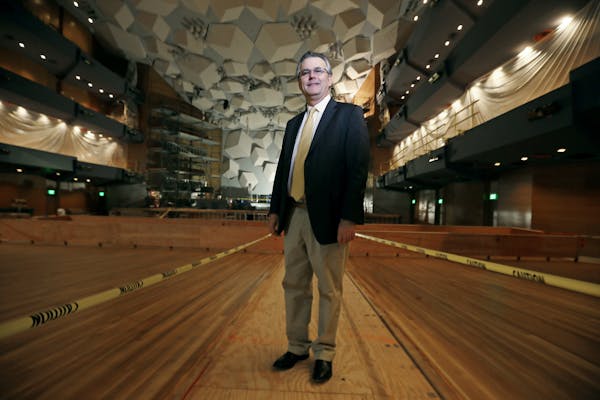Legislative and community leaders are considering giving more public money to the Minnesota Orchestra as its yearlong labor dispute leaves the future of the state's largest arts organization — and its stellar reputation — in limbo.
The orchestra seems no closer to settling than when the musicians were locked out on Oct. 1, 2012. Leaders, including former Gov. Arne Carlson, wonder why, if the Vikings stadium is getting $450 million in taxpayer money, the state can't come up with at least a sizable chunk of the $6 million needed to resolve the orchestra's deficit.
"The orchestra is a vital state asset that should receive the same attention as the stadium," said Carlson, who is leading a call for more civic-leader involvement. "If it doesn't, we'll live to regret it."
Comparing the economic impact of the Vikings and the orchestra to peripheral businesses, Carlson said, "The Vikings bring 502,000 people downtown eight times in one season. The orchestra brings 305,000 people downtown over a whole year."
Some legislators, as well as Gov. Mark Dayton, agree with Carlson that the idea should be explored before the Legislature reconvenes in February. But, they say, making it happen could be a steep challenge.
For one thing, the first idea that springs to many minds — using Legacy funds for an emergency fix — is moot. Accessing these sales-tax-generated funds, which have aided arts groups across the state since they were first made available in 2009, would not be possible until 2015, because the $26.7 million allocated for fiscal year 2014 already has been committed. Also, most of the grants have been for comparatively small amounts, distributed among a large number of the more than 1,600 arts groups, and a grant of several million would be an unusual step.
Larry Redmond, who has lobbied on behalf of the arts in Minnesota for more than 30 years, said any plan to give the orchestra "something extra" has to be viewed in terms of how it affects the total system.
"If you take money that's supposed to be going to other arts organizations, you're just shifting around who's sick," he said. "You can't solve one problem by creating 20 new ones. But you also can't have some things that are elemental to Minnesota's state brand, like our parks and the orchestra, without government being a part of it."
The state's general fund could be an option, but the Legislature as a rule does not earmark funds for specific arts organizations. That is left that up to the Minnesota State Arts Board and the state's 11 regional arts councils, which also are in charge of distributing Legacy funds. These groups are better equipped to assess the worthiness of arts-grant applications. Also, keeping individual arts organizations from appealing directly to the Legislature assures a more-level playing field.
State funding may be given to specific organizations to build facilities like stadiums and concert halls — the recent renovation of Orchestra Hall was underwritten in part by $14 million in state bonding — but not to help pay salaries, which is the primary sticking point in the orchestra labor dispute.
"The maintenance of a world-quality orchestra is important to Minnesota, so it might be appropriate to explore public support," said Sen. Dick Cohen, DFL-St. Paul, the chairman of the Senate Finance Committee and a key proponent of the Arts and Cultural Heritage segment of the Legacy fund. But, he said, doing so would require buy-in across several factions, including both sides of the orchestra dispute, state and local governments, and the arts community.
Cohen's caution is echoed by Scott Dibble, DFL-Minneapolis, an outspoken arts supporter, who calls Carlson's stadium parallel "a fair comparison. But the state government needs to be careful about swooping in on the funding crisis of one particular organization involved in a labor dispute when both sides have violated the public trust."
Dibble said he "is not closed to the idea, but there are a lot of marquee cultural institutions in Minnesota, and it's a question of fairness," referring to other prominent arts organizations. The St. Paul Chamber Orchestra, for one recent example, resolved its lengthy labor dispute earlier this year without a special infusion of state dollars.
Dibble will co-author a bill being introduced next session by Rep. Phyllis Kahn offering another possible resolution of the orchestra's woes — community ownership, an idea she previously floated concerning the Minnesota Twins. While both orchestra musicians and management are remaining mute on this concept, others don't count it out. "Just because it's an old idea doesn't mean it's not valid," Carlson said.
Working in the orchestra's favor for a funding increase is that the annual amount it gets from the state — close to $1 million a year — has either dipped as low as half that figure or remained flat over the last 15 years, a period when costs have risen by 22 percent, said orchestra-management spokeswoman Gwen Pappas.
Working against it is a behind-the-scenes attitude prevalent among some legislators that the orchestra, unlike football, is an amenity only for the well-to-do elite.
Carlson disagrees. "It costs a lot more to go to a Vikings game than an orchestra concert," he said.
Kristin Tillotson • 612-673-7046
The Latest: Trump takes to social media before Supreme Court arguments
Army reservist who warned about Maine killer before shootings to testify before investigators
The Latest | Trump arrives at court for hush money trial's third day

